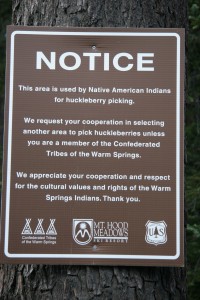NW Huckleberry Workshop
Enhancing and Restoring Huckleberry Areas in a Healthy Watershed Approach to Management
June 10-11, 2008
Kah-Nee-Ta High Desert Resort
Warm Springs, Oregon
Sponsors: NW Oregon Ecology Group & Mt Hood National Forest, Confederated Tribes of Warm Springs, Confederated Tribes of Siletz Indians, Mt Hood Meadows Ski Resort, Pacific Northwest Research Station, OSU Extension Service
Agenda
Keynote Address
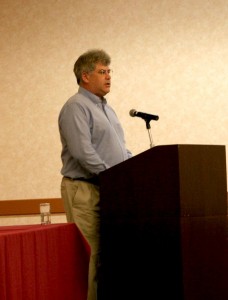 Don Motanic – Intertribal Timber Council
Don Motanic – Intertribal Timber Council
"A Huckleberry Trust Walk: Monitoring the Effectiveness of the Federal-Tribal Trust Relationship under the Northwest Forest Plan"
In a Trust Walk, two people alternate being the visionary leader and blindfolded follower to guide each other through an obstacle course. Both learn communication skills and develop a sense of trust. The NW Forest Plan requires monitoring of federal-tribal relationships (the consultation processes and impacts to resources, rights and interests of affected tribes). In addition, the federal government has trust responsibilities to protect and manage use and access to culturally important resources. To move forward in sustainable management of huckleberries, tribal and federal governments need to connect, share information and methods, and integrate the cultural connection with resource management; we need do the "huckleberry trust walk".
Awareness – cultural significance of the huckleberry resource, current research, balancing needs
Heather Erickson – USFS Portland Forestry Sciences, Research Ecologist
Huckleberry ecology, summary of published research, and future research needs.
Cultural Panel
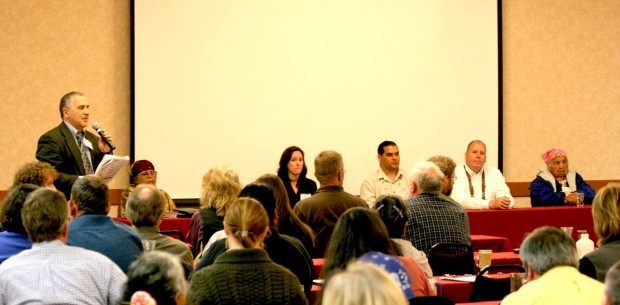
5 tribal perspectives of the importance of the huckleberry resource and cultural needs. (Left to right)
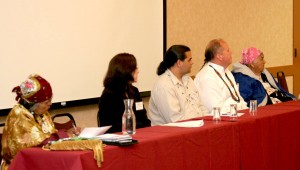
- Ruth Jim – Tribal Council, Confederated Tribes and Bands of the Yakama Indian Nation
- Jessica Bochart – archaeologist, Cow Creek Band of Umpqua Tribe of Indians
- David Lewis – cultural resource manager, Confederated Tribes of Grand Ronde
- Robert Kentta – cultural resource director, Confederated Tribes of Siletz Indians
- Adeline Miller – Tribal elder, Confederated Tribes of Warm Springs
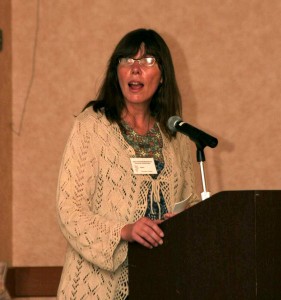 Joyce LeCompte-Mastenbrook – 2nd year PhD student of environmental anthropology, University of Washington
Joyce LeCompte-Mastenbrook – 2nd year PhD student of environmental anthropology, University of Washington
A dissertation proposal and preliminary results of a comparative study looking at factors that contributes to sustainability & equitable management of huckleberries and barriers.
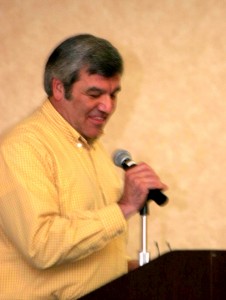 Frank Duran – USFS Region 6 Special Forest Products Regional Program Manager
Frank Duran – USFS Region 6 Special Forest Products Regional Program Manager
National and regional special forest products policy from a management perspective, what forests are doing in their permitting systems or should be doing. And, policy and our ability to work with the tribes as related to huckleberries and special forest products.
Huckleberry Management – Who is doing what?
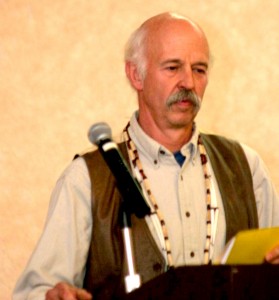 Tony Farque –Willamette NF, Sweet Home Ranger District Archaeologist
Tony Farque –Willamette NF, Sweet Home Ranger District Archaeologist
The Cougar Rock Huckleberry Enhancement project, a Title II project involves thinning/pruning/ hand piling with a focus is on increasing collaboration with Grand Ronde & Siletz tribes.
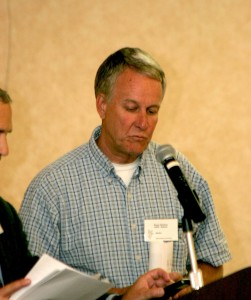 Bruce Holmson – Gifford Pinchot NF Silviculturist (retired)
Bruce Holmson – Gifford Pinchot NF Silviculturist (retired)
The Mowich project is a 51 acre commercial thinning followed by a prescribed underburn for huckleberry enhancement.
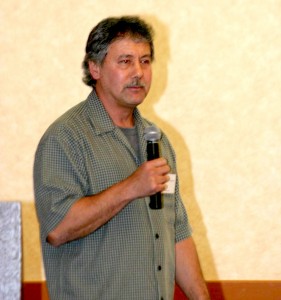 Steve Boyer – Gifford Pinchot NF, Cowlitz Valley Ranger District Silviculturist
Steve Boyer – Gifford Pinchot NF, Cowlitz Valley Ranger District Silviculturist
Precommercial thin in lodgepole for fuels reduction and huckleberry enhancement. Monitoring effectiveness of the thin to enhance huckleberries.
 Matthew Drake – CEO of Mt Hood Meadows Ski Resort
Matthew Drake – CEO of Mt Hood Meadows Ski Resort
Partnership formed with CTWS elders for berry picking areas protected (on volunteer basis) from the general public.
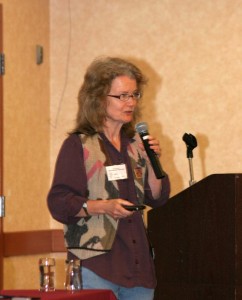 Cheryl Mack – Gifford Pinchot NF Archaeologist
Cheryl Mack – Gifford Pinchot NF Archaeologist
Sawtooth Huckleberry Restoration project, a landscape-level approach to restore the Sawtooth Huckleberry fields, a place of recognized cultural importance to the Yakama Nation. The project plans to treat 1200 acres using a variety of methods for reducing tree canopy cover. The cultural importance of the Sawtooth area will be discussed, along with historic records describing Indian use of fire in managing huckleberries.
Susan Charnley – Research Social Scientist, PNW Research Station
Integrating traditional and local ecological knowledge into forest biodiversity conservation in the PNW.
 Matt Jimenez/Jim Rice – BIA Planning Forester/Mt Hood Timber Products Officer
Matt Jimenez/Jim Rice – BIA Planning Forester/Mt Hood Timber Products Officer
Review of a huckleberry enhancement projects using winter logging (over snow) to protect established huckleberry plants.
Huckleberry Workshop Wrap Up
Literature that was available at the Huckleberry Workshop
- A social history of wild huckleberry harvesting in the Pacific Northwest. Richards, Rebecca T.; Alexander, Susan J. 2006. Gen. Tech. Rep. PNW-GTR-657.
- Once gathered only for subsistence and cultural purposes, wild huckleberries are now also harvested commercially. Drawing on archival research as well as harvester and producer interview and survey data, an inventory of North American wild huckleberry plant genera is presented, and the wild huckleberry harvesting patterns of early Native Americans and nonindigenous settlers are described. National forest management issues related to the industry are presented as are possible strategies that land managers could develop to ensure wild huckleberry, wildlife, and cultural sustainability.
- Huckleberry abundance, stand conditions, and use in western Oregon: evaluating the role of forest management. Kerns, Becky K; Alexander, Susan J.; Bailey, John D. 2004.
- Huckleberries are major components of the understory vegetation in coniferous Pacific Northwest forests of the United States. Vaccinium species also have a long history of human use. However, little research has been done to ascertain how they respond to common forest management practices. We used data obtained from old-growth, young thinned, and young unthinned Douglas-fir stands in western Oregon to evaluate how forest management could potentially influence species abundance and product supply. Our analysis focused on three species: Vaccinium ovatum, V. parvifolium, and V. membranaceum.
- Traditional and local ecological knowledge about forest biodiversity in the Pacific Northwest. Charnley, Susan; Fischer, A. Paige; Jones, Eric T. 2008. Gen. Tech. Rep. PNW-GTR-751.
- This paper synthesizes the existing literature about traditional and local ecological knowledge relating to biodiversity in Pacific Northwest forests in order to assess what is needed to apply this knowledge to forest biodiversity conservation efforts. We focus on the ecological knowledge of three groups who inhabit the region: American Indians, family forest owners, and commercial nontimber forest product (NTFP) harvesters.
- Growing Western Huckleberries.
- Danny L. Barney. 1999. University of Idaho, Sandpoint Research & Extension Center.
Research is underway to develop plants and cultural practices that will allow huckleberries to be grown domestically. This grower’s guide provides recommendations intended as a starting point for your own experiments in home or commercial huckleberry production. - Flower and Fruit Production of Understory Shrubs in Western Washington and Oregon
- Bryan W. Wender, Constance A. Harrington, John C. Tappeiner, II. 2004. Northwest Science.
We observed flower and fruit production for nine understory shrub species in western Washington and Oregon and examined the relationships between shrub reproductive output and plant size, plant age, site factors, and overstory density to determine the factors that control flowering or fruiting in understory shrubs.
Other Literature of Interest
- Special forests products: species information guide for the Pacific Northwest. Vance, Nan C.; Borsting, Melissa; Pilz, David; Freed, Jim. 2001. Gen. Tech. Rep. PNW-GTR-513.
- This guide is a collection of information about economically important vascular and nonvascular plants and fungi found in the Pacific Northwest that furnish special forest products. It provides a consolidated information resource that briefly describes biological, ecological attributes of over 60 plants and fungi, and their wild harvest methods, alternatives to wild harvest, and uses.
- Huckleberry ecology and management research in the Pacific Northwest. Minore, Don; Smart, A.W.; Dubrasich, M.E. 1979. Gen. Tech. Rep PNW-GTR-093.
- Big huckleberry (Vaccinium membranaceum Doug. ex. Hook.) berry production is declining in many northwestern huckleberry fields as they are invaded by subalpine trees. Seeking ways to halt this invasion and increase berry production, the authors studied huckleberries in the Cascade Range of Oregon and Washington from 1972 through 1977. They developed methods of growing huckleberries in the laboratory, tested several methods of controlling competing vegetation in the field, and recorded the changes in plant species composition and huckleberry production that resulted from applying these methods. This illustrated report includes descriptions of the experiments performed, results, conclusions, and management recommendations. It is a summary of the huckleberry research accomplished by personnel of the Pacific Northwest Forest and Range Experiment Station during the 6-year study period.
- In search of ecological advantages : mycorrhizal facilitation of big huckleberry Vaccinium membranaceum (Doug.). Stocking, Peter. 2006.
Links
- Dan Barney’s University of Idaho, Sandpoint Research &Extension Center. Huckleberry and bilberry research program
- USDA Fire Effects Information Database for Vaccinium membranaceum. Rocky Mountain Research Station, Fire Sciences Laboratory in Missoula, Montana.
- Northwest Berry & Grape Information Network
- USDA Plants Database
Speaker Contact Information
Cultural Panel Photos


